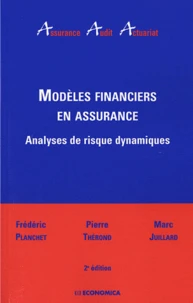Insurance Data Analytics. Some Case Studies of Advanced Algorithms and Applications
Par : ,Formats :
- Paiement en ligne :
- Livraison à domicile ou en point Mondial Relay estimée à partir du 2 décembreCet article sera commandé chez un fournisseur et vous sera envoyé 5 jours après la date de votre commande.
- Retrait Click and Collect en magasin gratuit
- Livraison à domicile ou en point Mondial Relay estimée à partir du 2 décembre
- Réservation en ligne avec paiement en magasin :
- Indisponible pour réserver et payer en magasin
- Nombre de pages403
- PrésentationBroché
- FormatGrand Format
- Poids0.565 kg
- Dimensions15,5 cm × 24,0 cm × 2,0 cm
- ISBN978-2-7178-7137-1
- EAN9782717871371
- Date de parution04/09/2020
- CollectionAssurance Audit Actuariat
- ÉditeurEconomica
Résumé
The use of algorithms exploiting heterogeneous and often high-volume data has developed very rapidly in recent years, taking advantage of increasing computing capacity and data collected by GAFA. These techniques first appeared in the insurance world to meet management or marketing needs : dimensioning of call centers, customer selection, automated analysis of contractual clauses, automation of underwriting processes, etc.
Even if a few old attempts can be spotted, it is only recently that actuaries have started to integrate data science techniques more systematically into their "toolbox" and have started to identify issues where these approaches could prove to be more efficient than the usual approaches. In this book, at the crossroads of actuarial and data science, you will find a state of the art of the use of these techniques for risk analysis and quantification.
Intended for students, academics and practitioners, it aims to provide a working basis and lines of thought for an enlightened use of data science in actuarial science.
Even if a few old attempts can be spotted, it is only recently that actuaries have started to integrate data science techniques more systematically into their "toolbox" and have started to identify issues where these approaches could prove to be more efficient than the usual approaches. In this book, at the crossroads of actuarial and data science, you will find a state of the art of the use of these techniques for risk analysis and quantification.
Intended for students, academics and practitioners, it aims to provide a working basis and lines of thought for an enlightened use of data science in actuarial science.
The use of algorithms exploiting heterogeneous and often high-volume data has developed very rapidly in recent years, taking advantage of increasing computing capacity and data collected by GAFA. These techniques first appeared in the insurance world to meet management or marketing needs : dimensioning of call centers, customer selection, automated analysis of contractual clauses, automation of underwriting processes, etc.
Even if a few old attempts can be spotted, it is only recently that actuaries have started to integrate data science techniques more systematically into their "toolbox" and have started to identify issues where these approaches could prove to be more efficient than the usual approaches. In this book, at the crossroads of actuarial and data science, you will find a state of the art of the use of these techniques for risk analysis and quantification.
Intended for students, academics and practitioners, it aims to provide a working basis and lines of thought for an enlightened use of data science in actuarial science.
Even if a few old attempts can be spotted, it is only recently that actuaries have started to integrate data science techniques more systematically into their "toolbox" and have started to identify issues where these approaches could prove to be more efficient than the usual approaches. In this book, at the crossroads of actuarial and data science, you will find a state of the art of the use of these techniques for risk analysis and quantification.
Intended for students, academics and practitioners, it aims to provide a working basis and lines of thought for an enlightened use of data science in actuarial science.









